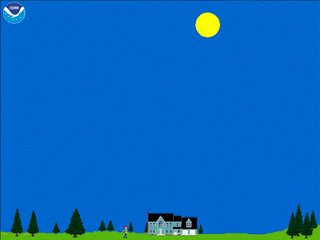Thunderstorms typically develop in the warmer months of spring, summer, and fall, but they can occur at any time of the year over most of the United States. There are three basic ingredients needed for thunderstorm development: moisture, an unstable atmosphere, and some way to start the atmosphere moving.
 Moisture is necessary to produce the thunderstorm clouds and precipitation. In the summertime, most areas of the United States have sufficient moisture to generate thunderstorms if the other ingredients are present. In the wintertime, thunderstorms favor southern areas of the United States where moisture is more plentiful; however, southerly winds associated with well-developed storm systems can bring sufficient moisture northward to generate thunderstorms at any time of the year, even in the dead of winter.
Moisture is necessary to produce the thunderstorm clouds and precipitation. In the summertime, most areas of the United States have sufficient moisture to generate thunderstorms if the other ingredients are present. In the wintertime, thunderstorms favor southern areas of the United States where moisture is more plentiful; however, southerly winds associated with well-developed storm systems can bring sufficient moisture northward to generate thunderstorms at any time of the year, even in the dead of winter.
Atmospheric stability, or more importantly, instability, also plays an important role in thunderstorm development. Rising air is needed to produce clouds, and rapidly rising air is needed to produce thunderstorms. For air to rise rapidly, it must become buoyant compared to the surrounding air. When the atmosphere is unstable, air near the ground can become buoyant and rise rapidly through the atmosphere. In general, the warmer the air is near the earth's surface and the colder the air is aloft, the more unstable the atmosphere is. In addition to temperature, moisture near the ground can also contribute to the instability of the atmosphere.
The third ingredient needed for thunderstorm development is something that will trigger motion in the atmosphere. This may be some sort of boundary such as a front, heating caused by the sun, or cooling aloft. Once a thunderstorm has developed, it will continue to generate boundaries that can trigger additional storms.
In the summer, thunderstorms typically develop in the afternoon when the sun heats air near the ground. If the atmosphere is unstable, bubbles of warm air will rise and produce clouds, precipitation, and eventually lightning.
Learn about Thunderstorm Electrification or return to Contents page